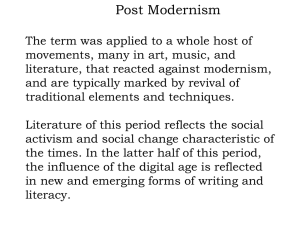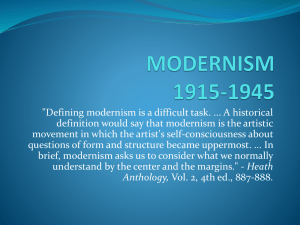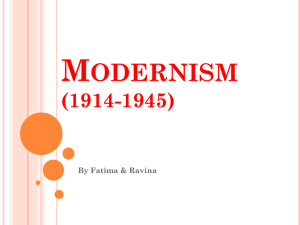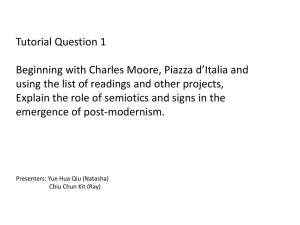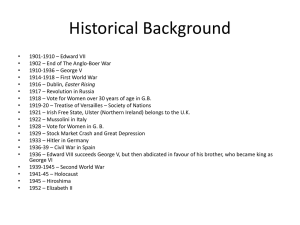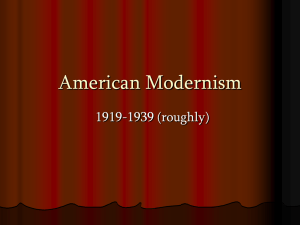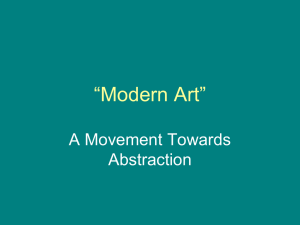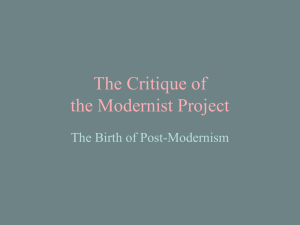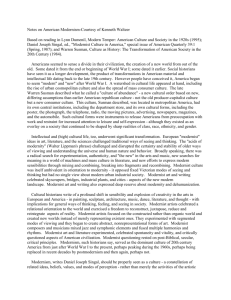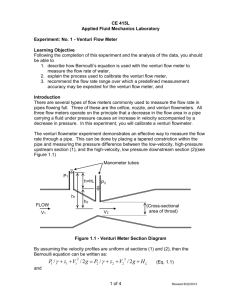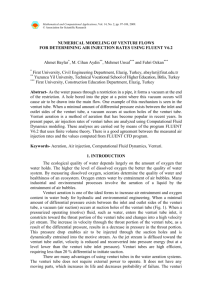Lecture-9&10ARCG411
advertisement
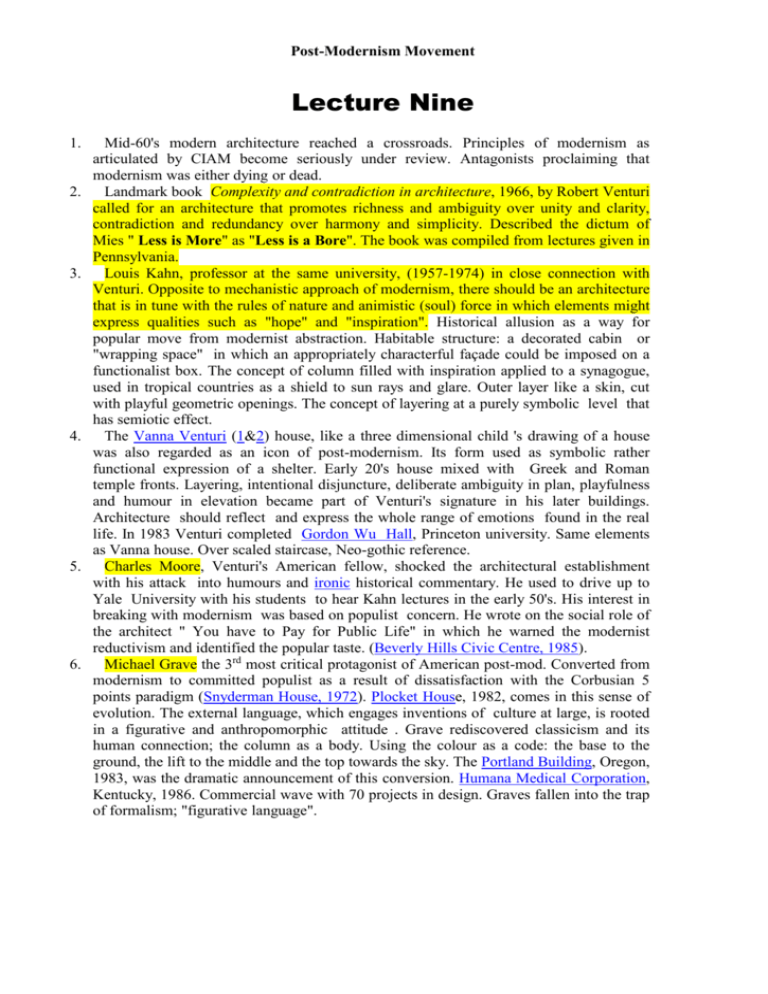
Post-Modernism Movement Lecture Nine 1. 2. 3. 4. 5. 6. Mid-60's modern architecture reached a crossroads. Principles of modernism as articulated by CIAM become seriously under review. Antagonists proclaiming that modernism was either dying or dead. Landmark book Complexity and contradiction in architecture, 1966, by Robert Venturi called for an architecture that promotes richness and ambiguity over unity and clarity, contradiction and redundancy over harmony and simplicity. Described the dictum of Mies " Less is More" as "Less is a Bore". The book was compiled from lectures given in Pennsylvania. Louis Kahn, professor at the same university, (1957-1974) in close connection with Venturi. Opposite to mechanistic approach of modernism, there should be an architecture that is in tune with the rules of nature and animistic (soul) force in which elements might express qualities such as "hope" and "inspiration". Historical allusion as a way for popular move from modernist abstraction. Habitable structure: a decorated cabin or "wrapping space" in which an appropriately characterful façade could be imposed on a functionalist box. The concept of column filled with inspiration applied to a synagogue, used in tropical countries as a shield to sun rays and glare. Outer layer like a skin, cut with playful geometric openings. The concept of layering at a purely symbolic level that has semiotic effect. The Vanna Venturi (1&2) house, like a three dimensional child 's drawing of a house was also regarded as an icon of post-modernism. Its form used as symbolic rather functional expression of a shelter. Early 20's house mixed with Greek and Roman temple fronts. Layering, intentional disjuncture, deliberate ambiguity in plan, playfulness and humour in elevation became part of Venturi's signature in his later buildings. Architecture should reflect and express the whole range of emotions found in the real life. In 1983 Venturi completed Gordon Wu Hall, Princeton university. Same elements as Vanna house. Over scaled staircase, Neo-gothic reference. Charles Moore, Venturi's American fellow, shocked the architectural establishment with his attack into humours and ironic historical commentary. He used to drive up to Yale University with his students to hear Kahn lectures in the early 50's. His interest in breaking with modernism was based on populist concern. He wrote on the social role of the architect " You have to Pay for Public Life" in which he warned the modernist reductivism and identified the popular taste. (Beverly Hills Civic Centre, 1985). Michael Grave the 3rd most critical protagonist of American post-mod. Converted from modernism to committed populist as a result of dissatisfaction with the Corbusian 5 points paradigm (Snyderman House, 1972). Plocket House, 1982, comes in this sense of evolution. The external language, which engages inventions of culture at large, is rooted in a figurative and anthropomorphic attitude . Grave rediscovered classicism and its human connection; the column as a body. Using the colour as a code: the base to the ground, the lift to the middle and the top towards the sky. The Portland Building, Oregon, 1983, was the dramatic announcement of this conversion. Humana Medical Corporation, Kentucky, 1986. Commercial wave with 70 projects in design. Graves fallen into the trap of formalism; "figurative language". Post-Modernism Movement Lecture Ten 7. Philip Johnson (b. 1906) changed style from Mies to Post-Mod. AT&T Bdg, NY, 1979. Chippendale tall-boy (18th English Furniture Style). Post-Mod in USA reflect the American Big, Bold and Brash taste for buildings. 8. In Europe; post-mod has been more ambiguous. Aldo Rossi and Leon Crier architectstheorists investigated in the typo-morphology and reconstruction of the European city. In France; Francois Leotard post-mod related to the field of language and semiotics. Eclecticism fed by diverse cultural influences, took precedence over the unified version of modernism. 9. A key moment of post mod in Europe, the Venice Architecture Biennale, 1980 organised by Paolo Porthoghesi, entitled the presence of the past, published in a book Post Modernism. It grouped all the well known architects of the movement. 10. James Stirling, the British architect moved away from modernism (Stuttgard Music School, 1995). Staatsgallery, Stuttgard , 1984, Cornell University, 1988. Romantic aspect of a discovered ruin. Reinforcing the urban fabric of the city. The tower evokes at an abstract level the metaphor of the Italisn hilltown. Contextualism and historical metaphor used for Cornell University. Clore Gallery, London, 1985. 11. Terry Farrel played an important role in introducing post-mod to England. Most of his work was designed for commercial clients. He concluded architectural projects are easily digested by the public consciousness when they are based on historical images TV AM London, 1982, Vauxhall Cross, London,1988. 12. Ricardo Bofill from Spain opted for classicism for the project in Marne-La-Vallee, France ,1983. 13. John Outram, interest in the Vedic imagery (indian religion belonging to the Hindu culture that produced the Vedas). Architecture as a system of signs that can be easily read by the general public, the same way as the architecture of past societies. Example:the Temple of Storm, 1895. A semiotic way: exploring connection between linguistics and architecture. 14. Hans Hollen, the Austrian architect. Digging the building into the earth and creating artificial site for purpose of contextualism (Munchenglabach Museum, 1982), (Haas House, Vienna, 1990). Return to the traditional relationship between urban space and architectural object (Museum of Modern Art, Frankfurt, 1991). 15. Arcquitectonica partnership in Miami: it is hard to imagine Atlantis anywhere else. It is contextually specific through imagery. (Banko de Credito, Lima, 1988). Using Pilotis to preserve site. 16. Post modernism offered a style that was easily imitated and exceptionally vulnerable for commercial debasement. Sometimes it leads to poor design that erodes serious intellectual respect for the movement, due to its superficiality Venturi Seattle Art Museum, 1991.
